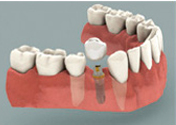
Dentures are false teeth made to replace teeth you have lost. Dentures can be complete or partial.
Complete dentures cover your entire upper or lower jaw. Partials replace one or a few teeth.
Advances in dentistry have made many improvements in dentures. They are more natural looking and comfortable than they used to be. But they still may feel strange at first. In the beginning, your dentist may want to see you often to make sure the dentures fit. Over time, your mouth will change and your dentures may need to be adjusted or replaced. Be sure to let your dentist handle these adjustments.
Do you need dentures?
If you′ve lost all of your natural teeth, whether from periodontal disease, tooth decay or injury, complete dentures can replace your missing teeth and your smile. Replacing missing teeth will benefit your appearance and your health. Without support from the denture, facial muscles sag, making a person look older. You′ll be able to eat and speak; things that people often take for granted until their natural teeth are lost.
Benefits of wearing dentures:
Masticatory – improving chewing ability by replacing the edentulous area with acrylic teeth. Thus enable better mastication and pleasure to enjoy food.
Aesthetic – providing the illusion of having natural teeth, providing support for their lips and cheeks, and correcting the collapsed appearance commonly seen between the nose and the chin.
Phonetic – Replacing the toothless area, especially the anteriors, to help patients to speak and pronounce certain words properly without air escapes.
How are dentures made?
Conventional dentures are made and inserted after your teeth have been taken out and the gums have healed.
A conventional denture can be made and is fitted typically within four or more appointments over one to two months. The process starts with an appointment with your dentist for an exam and a discussion of what will work best for you. In later visits, your dentist will take impressions of your mouth and establish the bite (the way your teeth come together). You and your dentist will select the teeth for your denture. The size, shape and color of the teeth will depend on many factors, including reference points in your mouth, your skin tone and the shape of your skull, photographs, etc.
At your trial fitting, your teeth will be set up and tried in your mouth. You can see how the denture looks and feels in your mouth, and your dentist can make sure it fits and functions correctly and harmonizes with the rest of your face. This is your denture preview, or “try-in.†If this goes well, you will receive the completed denture at the next visit, along with instructions from your dentist on eating, speaking, denture care and oral hygiene. Finally, you will need to see your dentist for a series of follow-up visits during the next few weeks and months to check the fit and comfort of your denture.








